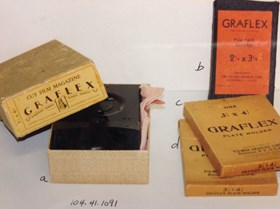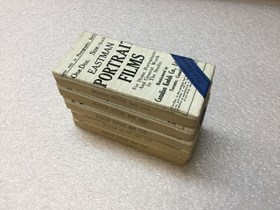Narrow Results By
- Date
- 1920 – 1940
- Material
- metal; skin; glass; fibre; paper; wood
- Catalogue Number
- 104.41.1091 a-d
- Description
- Graflex cut film magazine 3 1/4 x 4 1/4 (a), marked “GRAFLEX CUT FILM MAGAZINE. PAT. SEPT. 7, 1920. OTHER PATENTS PENDING. MADE IN U.S.A. BY EASTMAN KODAK CO. FOLMER & SCHWING DEPT. ROCHESTER, N.Y., in original labeled cardboard box. “GRAFLEX FILM PACK ADAPTER 2 1/4 x 3 1/4, Manufactured by THE FOL…
1 image
- Title
- Cut-Film Holder
- Date
- 1920 – 1940
- Material
- metal; skin; glass; fibre; paper; wood
- Dimensions
- 5.5 x 12.0 x 17.5 cm
- Description
- Graflex cut film magazine 3 1/4 x 4 1/4 (a), marked “GRAFLEX CUT FILM MAGAZINE. PAT. SEPT. 7, 1920. OTHER PATENTS PENDING. MADE IN U.S.A. BY EASTMAN KODAK CO. FOLMER & SCHWING DEPT. ROCHESTER, N.Y., in original labeled cardboard box. “GRAFLEX FILM PACK ADAPTER 2 1/4 x 3 1/4, Manufactured by THE FOLMER GRAFLEX CORP., ROCHESTER, N.Y., U.S.A.” (b) in original black cardboard box with orange printed label. Two plate holders (c,d) marked “3 1/4 x 4 1/4 GRAFLEX PLATE PAT. JUNE 7, 1927. FOLMER GRAFLEX CORP. U.S.A.” in original labeled cardboard boxes.
- Subject
- photography
- Vaux family
- Credit
- Gift of Molly Vaux, New York, USA, 1999
- Catalogue Number
- 104.41.1091 a-d
Images
This material is presented as originally created; it may contain outdated cultural descriptions and
potentially offensive content.
Read more.
Film Magazine Case
https://archives.whyte.org/en/permalink/artifact104.41.0085
- Date
- 1920 – 1940
- Material
- leather; fabric; metal; paper
- Catalogue Number
- 104.41.0085
- Description
- Black hard-sided leather case with a hinged lid that clasps shut with two metal clasps on either side of a metal hinge lock and metal corner braces. There are two metal bases attached to the lid where a handle may have been attached, handle missing. Faded leather strap is attached with metal clasps…
1 image
- Title
- Film Magazine Case
- Date
- 1920 – 1940
- Material
- leather; fabric; metal; paper
- Dimensions
- 27.7 x 34.1 cm
- Description
- Black hard-sided leather case with a hinged lid that clasps shut with two metal clasps on either side of a metal hinge lock and metal corner braces. There are two metal bases attached to the lid where a handle may have been attached, handle missing. Faded leather strap is attached with metal clasps to rings mounted on both short sides of the case. There is a small square sticker, possibly a travel marker from Mexico, on the left-hand short side under the clasp. In the middle of the lid is a rectangular Canadian Pacific label that has “Film Case” written in black ink and a stamped “PROPERTY OF NICHOLAS MORANT BANFF, ALBERTA” in blue ink. Attached with a short piece of white string to the right-hand carry strap clasp is a paper Canadian Pacific tag that has something written in black ink that is badly damaged by water. A cataloguer tag is also attached to that clasp with “MORANT COLLECTION (film magazines)” written on it in black ink.The interior of the box is lined with a dark red fabric, possibly velvet and is divided into two compartments, the left one slightly larger than the right. The interior of the lid is also divided into two compartments that close off with snaps - small leather pull tabs allowed the compartments to be accessed. There are no manufacturer’s marks on the case. Found inside are three different film magazines.
- Credit
- Gift of Nicholas Morant, Banff, 2006
- Catalogue Number
- 104.41.0085
Images
This material is presented as originally created; it may contain outdated cultural descriptions and
potentially offensive content.
Read more.
- Date
- 1920 – 1940
- Material
- metal; leather; plastic; celluloid
- Catalogue Number
- 104.41.0086 a-c
- Description
- Three black metal and leather “GRAFLEX CUT FILM MAGAZINE,” used to store individual celluloid negatives mounted into individual sleeves housed inside the main body. Access to the main body is possible by removing the the thin back panel with a leather strap that slides up alongside the leather bag …
1 image
- Title
- Film Magazines
- Date
- 1920 – 1940
- Material
- metal; leather; plastic; celluloid
- Dimensions
- 11.0 x 3.5 x 6.5 cm
- Description
- Three black metal and leather “GRAFLEX CUT FILM MAGAZINE,” used to store individual celluloid negatives mounted into individual sleeves housed inside the main body. Access to the main body is possible by removing the the thin back panel with a leather strap that slides up alongside the leather bag as well by pressing a button on the edge opposite the leather bag, allowing the front panel to pop open. On the front panel that can pop off is a small peephole accessible by a spring-hinged cover. Two of the magazines, marked with a red and a white strip of fabric, have the front panels taped closed with a small piece of masking tape.The three magazines are meant for different kinds of film. The one marked with a small strip of green fabric is meant for “KODAK EXTACOLOR Professional Type S (Short Exposure),” the one marked with the red fabric is meant for “KODAK EKTACHROME Film 6116, Type B (Process E-3),” and the one marked with the white fabric is meant for “KODAK TRI-X PAN SHEET FILM (ESTAR Thick Base).” The individual slides housed inside the magazine with the green fabric may have unprocessed fogged negatives still in them.
- Subject
- Nicholas Morant
- photography
- Kodak
- film photography
- photo developing
- Canadian Pacific Railway
- Credit
- Gift of Nicholas Morant, Banff, 2006
- Catalogue Number
- 104.41.0086 a-c
Images
This material is presented as originally created; it may contain outdated cultural descriptions and
potentially offensive content.
Read more.
- Date
- 1920 – 1945
- Material
- metal; glass; plastic;
- Catalogue Number
- 104.41.0171 a-c
- Description
- Four pieces from different manufacturers that make up a viewer for 16mm film, includes:Zeiss Moviscop : a grey-blue metal machine with a small square screen above the mechanism that feeds the film through and illuminates it from below. On the left-hand side is an outlet where the power cord can be …
1 image
- Title
- Film Viewer
- Date
- 1920 – 1945
- Material
- metal; glass; plastic;
- Dimensions
- 25.9 x 14.5 x 7.6 cm
- Description
- Four pieces from different manufacturers that make up a viewer for 16mm film, includes:Zeiss Moviscop : a grey-blue metal machine with a small square screen above the mechanism that feeds the film through and illuminates it from below. On the left-hand side is an outlet where the power cord can be plugged in [power cord missing], and on the right-hand side is a a black plastic knob [possibly for feeding the film] and a switch.Moviloa [Hollywood, California, USA] : two grey metal film reel holders with wooden handles. Placed on either side of the viewing machine, these holders were used to hold the two ends of the film reel. CIR-Catozzo [Leo Catozzo of Rome, Italy] : grey metal film splicer. Consists of a plate that hinges upward with a black plastic handle so that the film [16mm] can be inserted, two hinged slicers on the right-hand side [one of which is on an angle], and a roll of clear adhesive tape mounted at the front. On the bottom of the splicer is a piece of masking tape that has HH Films written in blue ink.
- Credit
- Gift of Eddie Hunter, Banff, 1995
- Catalogue Number
- 104.41.0171 a-c
Images
This material is presented as originally created; it may contain outdated cultural descriptions and
potentially offensive content.
Read more.
- Date
- 1920 – 1930
- Material
- paper; cardboard;
- Catalogue Number
- 104.41.0209 a-e
- Description
- Five paper-wrapped boxes of one dozen 1 11/16 x 4 3/16 cm Eastman Portrait Films. Each box has a white paper lid that features the manufacturer details and the product type, as well as a blue paper “ribbon” in the bottom right corner with “Par-Speed” printed on it in black - the boxes are sealed sh…
1 image
- Title
- Film
- Date
- 1920 – 1930
- Material
- paper; cardboard;
- Dimensions
- 8.5 x 5.5 x 12.2 cm
- Description
- Five paper-wrapped boxes of one dozen 1 11/16 x 4 3/16 cm Eastman Portrait Films. Each box has a white paper lid that features the manufacturer details and the product type, as well as a blue paper “ribbon” in the bottom right corner with “Par-Speed” printed on it in black - the boxes are sealed shut with paper adhesives wrapped around the edges and bottoms. On one long side of each box is stamped “DEVELOP BEFORE MAY 1930.”Portrait Films were first introduced by Eastman Kodak in 1913 to replace glass plates and are suitable for home use or in professional studios.
- Credit
- Gift of Robert Crosby Family, Banff, 1998
- Catalogue Number
- 104.41.0209 a-e
Images
This material is presented as originally created; it may contain outdated cultural descriptions and
potentially offensive content.
Read more.
Film Projector
https://archives.whyte.org/en/permalink/artifact105.05.0044
- Date
- ca. 1930 – 1950
- Material
- metal; cable; glass
- Catalogue Number
- 105.05.0044
- Description
- A black, heavy, cast iron-like Apollo Sound 16mm film projector. It has a unique shape with an art deco type styling. One side of the projector features a switch and silver metal knobs where the tightly coiled spring would be placed to move the film. There is a label with instruction but is illegib…
1 image
- Title
- Film Projector
- Date
- ca. 1930 – 1950
- Material
- metal; cable; glass
- Dimensions
- 37.2 x 14.8 x 38.3 cm
- Description
- A black, heavy, cast iron-like Apollo Sound 16mm film projector. It has a unique shape with an art deco type styling. One side of the projector features a switch and silver metal knobs where the tightly coiled spring would be placed to move the film. There is a label with instruction but is illegible due to wear, herringbone-shaped cut-outs below that expose some of the mechanisms of the projector, next to these cut-outs is where the power cord connects to the projector, and towards the front of the projector is another cord that becomes wire that is wrapped around a smaller spool. Along the back side, in raised letters, text reads “APOLLO [vertical] SOUND [horizontal]”. On the very back of the projector are two switches and a black knob that props the back of the projector up slightly. The other side of the projector is the same raised text that reads “APOLLO [vertical] SOUND [horizontal]” near the back, and there is also a a sloped pattern cut-out near the bottom that exposes the fan of the projector. This side features the main part of the projector with the lens, reels, and the track for the film. The top of the projector features a handle-like design.
- Subject
- film
- 16mm film
- projector
- Apollo Sound
- Credit
- Gift of Dan MacDonald, Calgary, 1993
- Catalogue Number
- 105.05.0044
Images
This material is presented as originally created; it may contain outdated cultural descriptions and
potentially offensive content.
Read more.
Film Strip Projector
https://archives.whyte.org/en/permalink/artifact105.05.1015
- Date
- c. 1930
- Material
- metal; paper; glass
- Catalogue Number
- 105.05.1015
- Description
- 35 mm film strip projector and case. Simple design projector having rectangular metal base with manufacturer's nameplate. Tower one side of rectangle, housing a bulb. Chrome assembly attached to front of tower concealing first lens, second lens is detachable, rolled in handkerchief. Cylindrical sec…
1 image
- Title
- Film Strip Projector
- Date
- c. 1930
- Material
- metal; paper; glass
- Dimensions
- 21.8 x 15.3 x 21.3 cm
- Description
- 35 mm film strip projector and case. Simple design projector having rectangular metal base with manufacturer's nameplate. Tower one side of rectangle, housing a bulb. Chrome assembly attached to front of tower concealing first lens, second lens is detachable, rolled in handkerchief. Cylindrical section for the insertion of lens, curled flat chrome piece for holding filmstrip, gearing with knob, for advancing strip to next frame. Maroon electric cord coming from back. Black box made of cardboard with red felt inside. Bucket on front for locking. Leather carrying handle. Small box of slide labels marked "Ingram & Bell Ltd.".
- Subject
- photography
- Hubert Green
- Credit
- Gift of Hubert E. Green Jr., Banff, 1986
- Catalogue Number
- 105.05.1015
Images
This material is presented as originally created; it may contain outdated cultural descriptions and
potentially offensive content.
Read more.
Sheet Film Holder
https://archives.whyte.org/en/permalink/artifact104.41.1271%20a-d
- Date
- 1928 – 1946
- Material
- wood; metal
- Catalogue Number
- 104.41.1271 a-d
- Description
- black painted wooden double film holder with a metal septum in the middle and two dark slides with handles, one on each side, inserted in a recess and held by rivets; engraved on the wooden frame: “3 1/4 x 4 1/4 GRAFLEX FILM / FOLMER GRAFLEX CORP. U.S.A.” on one side and on the other side the paten…
1 image
- Title
- Sheet Film Holder
- Date
- 1928 – 1946
- Material
- wood; metal
- Dimensions
- 10.4 x 15.8 cm
- Description
- black painted wooden double film holder with a metal septum in the middle and two dark slides with handles, one on each side, inserted in a recess and held by rivets; engraved on the wooden frame: “3 1/4 x 4 1/4 GRAFLEX FILM / FOLMER GRAFLEX CORP. U.S.A.” on one side and on the other side the patent number: “U.S. PAT. 1631479 1641420 2056144”; stored in a blue faux leather covered cardboard box with white, golden and blue label reading: “3 1/4 x 4 1/4 CUT FILM MAGAZINE / GRAFLEX / MANUFACTURED BY GRAFLEX, INC., ROCHESTER 8, NEW YORK, U.S.A”; in pencil, the number 40.25 has been added above the printed label;a) has a piece of white tape stuck to one of its handles
- Subject
- Nicholas Morant
- photography
- Credit
- Gift of Nicholas Morant, Banff, 2006
- Catalogue Number
- 104.41.1271 a-d
Images
This material is presented as originally created; it may contain outdated cultural descriptions and
potentially offensive content.
Read more.
Old Swiss Guides - negatives
https://archives.whyte.org/en/permalink/descriptions57410
- Part Of
- Bruno Engler fonds
- Scope & Content
- File pertains to 4 b&w negatives of a commemorative plaque for Swiss Guides mounted on a rock with guide pins posed below it.
- Date Range
- 1901-1963
- Reference Code
- V190 / VI / O / v / NA - 01 to NA - 04
- Description Level
- 5 / File
- GMD
- Film
- Negative
- Part Of
- Bruno Engler fonds
- Description Level
- 5 / File
- Fonds Number
- M323 / S40 / V190
- Series
- VI : Retained file, O : Alphabetical order
- Sous-Fonds
- V190
- Sub-Series
- v : Old Swiss Guides
- Accession Number
- 7436
- Reference Code
- V190 / VI / O / v / NA - 01 to NA - 04
- Date Range
- 1901-1963
- Physical Description
- 4 photographs : b&w negatives ; 6.5 x 7.6 cm
- History / Biographical
- See fonds level description
- Scope & Content
- File pertains to 4 b&w negatives of a commemorative plaque for Swiss Guides mounted on a rock with guide pins posed below it.
- Name Access
- Aemmer, Rudolf
- Feuz, Edmund
- Feuz, Edward
- Feuz, Edward, Jr.
- Feuz, Ernest
- Kaufmann, Christian
- Hasler, Christian
- Subject Access
- Alpine Club of Canada
- Climbing
- Films and film making
- Guides
- Guiding
- Mountains
- Mountaineering
- Mountaineers
- Portrait
- Swiss Guides
- Geographic Access
- Lake Louise
- Banff National Park
- Language
- English
- Related Material
- V190 / VI / O / v / PA - 01 to PA - 19
- Creator
- Engler, Bruno
- Title Source
- Original title kept
- Processing Status
- Processed
This material is presented as originally created; it may contain outdated cultural descriptions and
potentially offensive content.
Read more.
Alpine Club of Canada fonds
https://archives.whyte.org/en/permalink/descriptions92
- Part Of
- Alpine Club of Canada fonds
- Scope & Content
- Fonds constitutes the principal resource for the study of the history of Canadian mountaineering. It provides a wealth of information on individual alpinists, expeditions, mountains, national parks, conservation, climbing, alpine organizations, publications, guiding, scientific study and the Alpin…
- Date Range
- 1906-2017
- Reference Code
- M200 / S6 / V14
- Description Level
- 1 / Fonds
- GMD
- Motion picture
- Film
- Video
- Photograph
- Album
- Negative
- Photograph print
- Postcard
- Transparency
- Sound recording
- Cassette
- Textual record
- Organization record
- Part Of
- Alpine Club of Canada fonds
- Description Level
- 1 / Fonds
- Fonds Number
- M 200
- S 6
- V 14
- Sous-Fonds
- M200
- S6
- V14
- Accession Number
- 698, 1040 (unproc), 1224, 1299 (unproc), 1807, 1813, 2141 (unproc), 2376 (unproc), 3160 (unproc), 3296 (unproc), 3298 (unproc), 3382 (unproc), 3560 (unproc), 3757 (unproc), 3970 (unproc), 5012, 5114, 5200, 5215 (unproc), 5330 (unproc), 5343, 5357, 5396 (unproc), 5438, 5454, 5455, 5456, 5457, 5458, 5459, 5460, 5461, 5462 (unproc), 5463 (unproc), 5464, 5465, 5466, 5474, 5538 (unproc), 5541, 5569 (unproc), 5591 (unproc), 5592, 5605, 5631 (unproc), 5632, 5633, 5634, 5635 (unproc), 5680 (unproc), 5724, 5950, 6062 (unproc), 6332, 6337, 6375, 6376 (unproc), 6396, 6437, 6451, 6457 (unproc), 6459 (unproc), 6465 (unproc), 6470 (unproc), 6623 (unproc), 6624, 6625, 6626, 6627 (unproc), 6628, 6765 (unproc), 6766 (unproc), 6767 (unproc), 7774 (unproc), 7779 (unproc), 8002 (unproc), 2021.32 (unproc)
- Reference Code
- M200 / S6 / V14
- GMD
- Motion picture
- Film
- Video
- Photograph
- Album
- Negative
- Photograph print
- Postcard
- Transparency
- Sound recording
- Cassette
- Textual record
- Organization record
- Date Range
- 1906-2017
- Physical Description
- ca.42 m of textual records. -- ca.12,500 photographs: prints, stereographic prints, transparencies, slides, negatives, postcards. -- 85 photograph albums. -- 8 motion pictures: films, video recordings. -- 3 sound recordings
- History / Biographical
- The Alpine Club of Canada, the national mountaineering club, was co-founded in 1906 by A. O. Wheeler and Elizabeth Parker, and other like-minded climbers. The club espoused scientific study and exploration, cultivation of art, public education, acquisition of climbing skills, and preservation of natural areas within the mountainous regions of Canada. Through a national executive, local sections and volunteer committees, the club provided climbing camps, clubhouse, huts, and publications, including the Canadian Alpine Journal. ACC expeditions and projects resulted in pioneer exploration, first ascents, and included mountain warfare training during the Second World War. In recent years, the club's membership has increased dramatically with the popularity of climbing and its programs have evolved to serve the needs of unguided climbers using sophisticated technical aids.
- Scope & Content
- Fonds constitutes the principal resource for the study of the history of Canadian mountaineering. It provides a wealth of information on individual alpinists, expeditions, mountains, national parks, conservation, climbing, alpine organizations, publications, guiding, scientific study and the Alpine Club itself.
- The fonds consists of four Sous-fonds: I. Alpine Club of Canada records; II. Mount Everest Expedition (1982) records; III. Personal papers and photographs; IV. Other material. Club administration records (series I.A.) pertain to executive positions; head office; finance; camps, climbing and treks; expeditions; huts and properties; clubhouses; library; publications; photography; other committees; other activities; and other. Other club records include section records (series I.B.), hut registers and summit records (series I.C.).
- Name Access
- Alpine Club of Canada
- Access Restrictions
- Some restriction/s on access
- Copyright, privacy, commercial use and other restrictions may apply
- Language
- Language is English
- Finding Aid
- Finding aids and reference tools: sous-fonds, series and sub-series description
- electronic finding aid for processed material
- Creator
- Alpine Club of Canada
- Title Source
- Title based on contents of fonds
- Processing Status
- Processed / Unprocessed
This material is presented as originally created; it may contain outdated cultural descriptions and
potentially offensive content.
Read more.
















